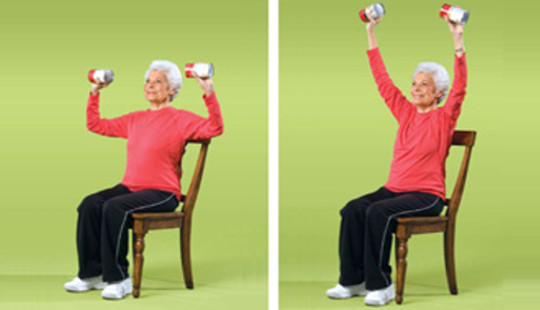
In the absence of major health problems, regular strength training leads to noticeably stronger muscles in only six to eight weeks, no matter what your age. One study of strength training in older men found that participants doubled the strength of their quadriceps after just three months. The quadriceps muscle, which runs along the front of the thigh, is critical for going up and down stairs and rising from a chair or toilet. To maintain (or regain) a basic level of independence, it is crucial to keep this muscle strong.
Strength training, especially when combined with aerobic exercise, is a surefire way to control body weight. Why? Because muscle burns calories and fat. The more muscle we have, the more calories we burn. But left to its own devices, the body loses about a half pound of muscle every year after age 30. If we don't keep ourselves strong, we gain weight with each passing year.
A recent study of older Americans found that seven out of ten women over age 70 are unable to lift 10 pounds. Yes, that's right. Seven out of ten older women cannot lift even 10 pounds! And this is not just a "female" problem. Seven out of twenty men over age 70 are just as frail. Think of the normal, everyday activities that become difficult if not impossible when you can't lift 10 pounds of weight: grocery shopping, vacuuming, working in the yard, doing the laundry, carrying a suitcase or heavy purse, holding a child, opening containers, getting in and out of a bathtub or deep chair, opening a window, moving pots and pans, setting the table, watering plants, walking a dog, shoveling snow, changing bedding. The list could go on and on. What happens when you can't do these activities by yourself? You depend on others to do them for you. And, in some cases, you lose the pleasures and benefits of these activities altogether.
All of us want to remain as active and independent as possible for as long as we can. All of us want to maintain a high quality of life as we age. The question is, can we do it, and if so, how?
Dorothy is a 75 year-old retired school teacher who maintains an active social life. She is very involved at her church and loves to travel, having taken two longs trips to Africa in the last few years. Except for a recent hip replacement, Dorothy has no major or chronic health concerns. She regularly visits nursing homes, cheering the occupants with her positive outlook and exuberant energy. Aerobic exercise and strength training are a routine part of Dorothy's week.
Why do some people, like Dorothy, maintain good health and an active lifestyle well into retirement, while many others experience ill health and loss of independence?
In the last decade we have learned that healthy aging is not simply a matter of fate or good genetics. Abundant scientific evidence has shown that maintaining muscular strength plays an important role in successful aging. Because Dorothy chooses to make strength training a part of her regular routine, she enjoys a healthy, vibrant lifestyle that has taken her halfway around the world.
WHAT IS STRENGTH TRAINING?
Mention strength training and a vision of youthful bodies lifting big barbells comes to mind. Few people associate strength training with older adults. But with some minor modifications, biceps curls and leg extensions are every bit as appropriate for those of us in our sixth, seventh, or even eighth and ninth decade of life. And the health benefits are tremendous. The concept is simple: Strength training is any activity that moves a body part against resistance. Resistance may be isometric (when you tighten a muscle and hold it for several seconds), or it might involve a small weight, a household object, or an exercise band (a 3- or 4-foot elastic band designed for exercise).
Strength training does not require a gym or membership in a health club. It need not involve expensive or heavy equipment. If we know a few simple principles and learn some basic exercises, we can do strength training at home, at the park, or with a group of friends.
WHY STRENGTH TRAIN?
Few older adults exercise to look good in a swimsuit. For most of us, strength training is critical to maintaining our health and our independence. The benefits of strength training are considerable -- and these benefits become evident in a very short time.
1. Bigger, Stronger Muscles
When we reach middle age, we begin to lose muscle mass. Our muscles literally begin to shrink and weaken. This is a natural process that medical professionals call sarcopenia. Once we hit age 70, our muscle loss accelerates. We may find it difficult to go up and down the stairs. A grocery bag or laundry basket may become too heavy. We might feel wobbly when walking across the room.
Weakness, difficulty with everyday activities, frail arms and legs -- these are not the inevitable results of age. When it comes to aging muscles, an old saying applies: "Use it or lose it."
Hilmer is a 65 year-old retired high school principal and basketball coach. Although he walks for thirty minutes, three or four times each week, he has recently noticed little changes in his physical abilities. Climbing the stairs requires greater effort. An hour of gardening leaves him sore and stiff the next day. It has become difficult to lift a golf bag. At his next physical, Hilmer discusses his concerns with his physician. The doctor commends Hilmer for walking regularly, but he recommends a simple exercise program to strengthen some important muscles.
Hilmer follows his doctor's recommendation. After six weeks he notices that simple daily tasks, like lifting a pan from the oven and pushing the mower across the lawn, are getting easier. Now, as he continues his strengthening exercises twice a week, Hilmer is lifting his golf bag as easily as he did fifteen years ago.
2. Stronger Bones
Strength training is one of the most important steps we can take to prevent osteoporosis and subsequent fractures. Osteoporosis, or loss of bone density, is a major health concern for older adults, particularly women. When bones lose density, they become weaker, making them more susceptible to fractures. Broken bones are not only painful, they can be life threatening as well.
Over the last decade, research has shown that regular strength training can help us strengthen our bones and avoid this potentially debilitating disease. And for those of us who already have osteoporosis, strength training can help us maintain or rebuild bone mass in our spine, hips, and wrists -- the areas most susceptible to fracture.
3. Improved Balance
As we age, we may begin to feel wobbly or off-balance, a condition that could lead to falls and serious injury. For some of us, walking, showering, even bending over to pick up a book may cause us to lose our balance.
Balance is a complex process involving muscles, nerves, and the vestibular system (an important part of the inner ear). Balance problems are often a sign of muscle weakness -- as we exercise and rebuild our muscle strength, our balance generally improves. Better balance reduces our chances of falling and makes simple daily tasks, like walking and showering, safer.
4. Fewer Falls
Falls are one of the most serious and common medical problems suffered by older adults. Every year, about one-third of people over 65 experience a fall. Falls cause bruises, fractures, and other injuries. And, once we have suffered a fall, we often develop a fear of falling that prevents us from participating in our normal activities.
Strong muscles decrease our chances of falling. If a fall does occur, strong muscles help protect our bones, making us less likely to experience a fracture or other serious injury.
5. Daily Tasks Are Easier
Most of us strength train because we want to improve our "functional strength." Functional strength is the amount of strength we need to accomplish our daily tasks. For example, if the washing machine is in the basement, we need to be strong enough to carry a load of laundry up and down the stairs. When grocery shopping, we must be strong enough to carry the groceries into the house from the car.
One study found that people between 75 and 80 years of age who led sedentary lives used more than half their muscular strength just to take a shower. This is not an inevitable sign of age -- this is a sign of muscle weakness. Regular strength training will prevent or reverse this muscle loss, giving us the strength we need in our daily lives.
6. Improved Mobility
Crossing the street before the light changes, climbing the stairs to our third-floor apartment, walking to the mailbox without running out of breath -- when modest goals like these become difficult, they jeopardize our independence.
Through strength training, we can improve our walking speed as well as our ability to climb stairs. In fact, strength training allows many of us to continue living in our homes long after our peers have moved to assisted living facilities.
7. Increased Activity Level
For many of us, the saying: "My get-up-and-go, got up and went" is a little too familiar. Feeling tired and weak, we might limit ourselves to sedentary activities, like watching television or reading on the couch. But when we begin strength training, we are surprised to find that we feel like doing more. We rediscover our "get-up-and-go."
In one study, a group of nursing home residents began regular strength-training sessions. They quickly started feeling stronger and doing more. In fact, their spontaneous physical activity increased by almost 30 percent. They began to prefer walking over sitting, and moving over being still.
8. Better Weight Control
If your goal is to lose weight or maintain your figure, strength training can help in two ways. First, your body burns calories and fat while you exercise. Second, when your muscles are strong and well-toned, your metabolism increases, causing your body to burn even more calories and fat all day long.
You can think of metabolism as how your body burns fuel (fat and calories) during the day. You burn fuel whenever you move, but also when you're at rest. (Imagine an idling car engine -- even when it isn't moving, it needs fuel to keep running.) As your muscles become stronger, your body must burn more fuel. Even if your strength-training sessions last only thirty minutes every other day, your metabolism can be elevated throughout the whole day, every day. You can even burn more calories in your sleep!
But remember, muscle weighs more than fat. This means that you may lose inches, but not necessarily pounds. As the fat melts away, it is replaced with strong, toned muscles, so the news from the bathroom scale may not seem encouraging. Do not despair. You will likely lose inches in critical places, like the waist and hips. You will look thinner and feel better, even if you don't lose much weight. Trust how you feel and look -- don't measure your success with the bathroom scale.
When George received a notice for his forty year class reunion, he decided that the tire around his waist and those few -- well, more than a few -- extra pounds had to go. George checked with his doctor and started a strength-training program. But as he stepped on the scale each week, the pounds weren't dropping off as he had expected. Just when he started to get frustrated, he began to hear compliments from his friends and family: "George, you're looking good. " "Are you losing weight, George?"
George went to his class reunion feeling good about his appearance. He had dropped several inches around the waist, even though he had shed only a few pounds.
COMMONLY ASKED QUESTIONS
This sounds too good to be true. Why haven't I heard it before?
Gerontology, or the study of aging, is a relatively new science. For a time, gerontology focused on disease and declining health -- conditions associated with aging. But in the last decade or so, science has begun to focus on aging healthily. Since then, research has shown that lifestyle choices play a critical role in determining our health, no matter what our age.
Strength training is one of the most important choices we can make. In fact, so much evidence has accumulated to support the link between good strength and good health that the American College of Sports Medicine recently revised its exercise recommendations for the first time in over a decade. They now recommend that every adult participate in a regular strength-training program.
Is strength training safe?
Strength training is safe for almost everyone. But, as with any exercise program, it's important to check with your doctor before you begin. If you take certain medications or suffer from a specific medical condition, strength training may cause undesirable -- or even dangerous -- symptoms.
If you perform your exercises correctly, the risk of injury is minimal. The most common reason for injury, regardless of a person's age, is trying to progress too quickly.
Is strength training all I need to do?
Strength training is just one part of a healthy lifestyle. You're probably familiar with the other parts: good nutrition, aerobic exercise (such as walking), and stretching exercises. Among people aged 65 to 74, two-thirds of women and three-fourths of men participate in some type of regular physical activity. But only 7 percent of men and 3 percent of women participate in a regular strength-training program. It's time to get the word out: As older adults, we need strength training to maintain (or regain) our health.
Reprinted with permission of the publisher,
Fairview Press. ©2000.
http://www.FairviewPress.org
Article Source
 Staying Strong: A Senior's Guide to a More Active and Independent Life
Staying Strong: A Senior's Guide to a More Active and Independent Life
edited by Lorie A. Schleck, MA, PT.
This book presents fun, easy, in-home exercises that will help seniors.
Info/Order this book.
About the Author
Lorie A. Schleck is a physical therapist at Fairview Rehabilitation Services. She received her BS degree in physical therapy from the University of Minnesota and her MA degree in counseling psychology from St. Mary's University of Minnesota. She has published numerous articles on physical therapy and fitness, is the editor of the book Staying Strong and is the coauthor of Shapewalking: Six Steps to a Healthier Life.
Books by Lorie Schleck
at InnerSelf Market and Amazon


























